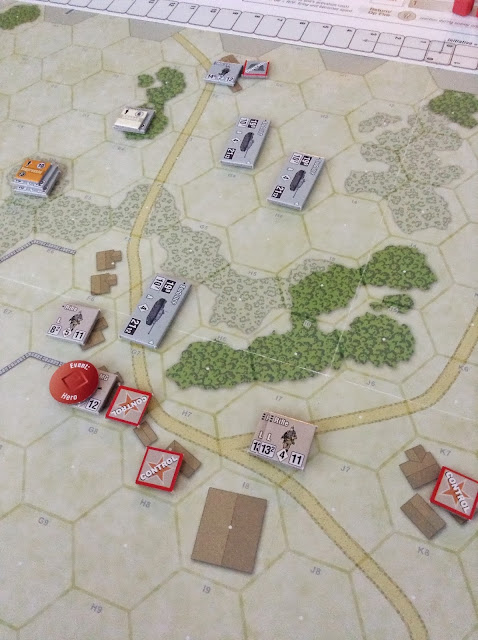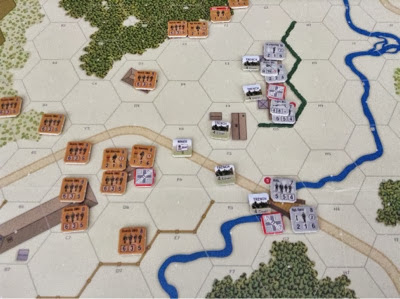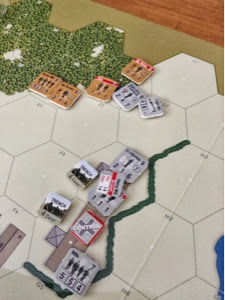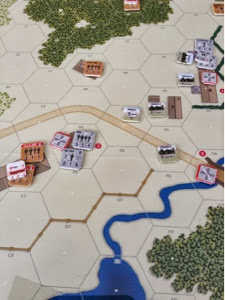Wednesday, May 18, 2016
Tuesday, April 29, 2014
Thursday, August 29, 2013
Fighting Formations
Hello, all! Lately, I've had a bit of downtime from work and getting my fill of hex and counter war gaming again. Between 'Combat Commander: Europe', and the beautifully produced second edition of 'Conflict of Heroes: Awakening the Bear!', I must say I've been spoiled with some amazing World War II-era games.
I've recently had the pleasure of playing Chad Jensen's 'Fighting Formations' from GMT games and want to tell you a little bit about it. Jensen has already made a name for himself with his excellent 'Combat Commander' series and his euro / wargame hybrid, 'Dominant Species' so when it was announced that he had another tactical wargame in the works, it got TONS of buzz.
For years, many people who played 'Combat Commander' have been impressed with its tight gameplay, crystal clear rules and cinematic experience. Occasionally, you'd hear someone say, "I wish it had tanks!!".
Well, I'm here to tell you that 'Fighting Formations' has many of 'Combat Commander's' strengths. And it has tanks. LOTS of them!
I want to back up a bit and talk about the beating heart of 'Fighting Formations': The Order Matrix.
Most war games have an alternating 'I-go-you-go" mechanic but Jensen comes up with an innovative approach to how each player issues orders in the game.
Simply put, cubes are randomly seeded onto the Order Matrix (as seen in the picture below), which have numerical initiative costs associated with orders such as 'Move', 'Rally', 'Fire', etc. Under the Order Matrix sits an initiative pawn that see-saws left and right on a track, based on the cost of said order. To give an order to your troops on the board, simply take that cube and the initiative pawn is then moved that many spaces towards your opponent's side of the initiative track.
The lovely thing with the Order Matrix is that asymmetric costs of giving orders are already 'baked' into it. The Soviets, for example, need to spend less initiative to move than the Germans, who in turn, spend less on 'Fire' orders, etc. Giving more expensive orders (drawing helpful asset cards, for example) will shift the initiative to your opponent who may, in turn, end up issuing two to three smaller cost orders in a row.
It's a simple, yet elegant design solution that highlights the strengths and weaknesses of each side without needing to reference tons of charts and remembering rules exceptions. Thus, you're free to concentrate more on tactics and playing the game.
Speaking of which, here's how giving orders translates to gameplay....
Within a given scenario, each player will have a command token to place on the battlefield. These tokens have a command radius that incurs an initiative cost depending on where the units are in relation to them. This simulates how well your troops respond to orders given on the battlefield.
In the picture below, you can see that the Germans have a '3' hex command radius, while the Russians only have 2. This makes the Germans a bit more flexible in this particular scenario.
Here you can see that by placing a Command Token (the round marker with a "0" on it), it costs zero for the Russians to activate their Russian platoons and tank within two hexes of that token. The tanks with the "stunned" hit marker, however, would have to activate for DOUBLE due to the fact that they're out of command range as well as not having radio communication (a nice historical detail that is highlighted in the game).
The units in the game usually start out as platoons with higher stats, which can then deploy down to squad-sized units, as seen below. This adds yet another level of tactics to consider: Should you keep your platoons and hope to do more damage, or deploy them to overrun your enemy at a higher initiative cost down the line?
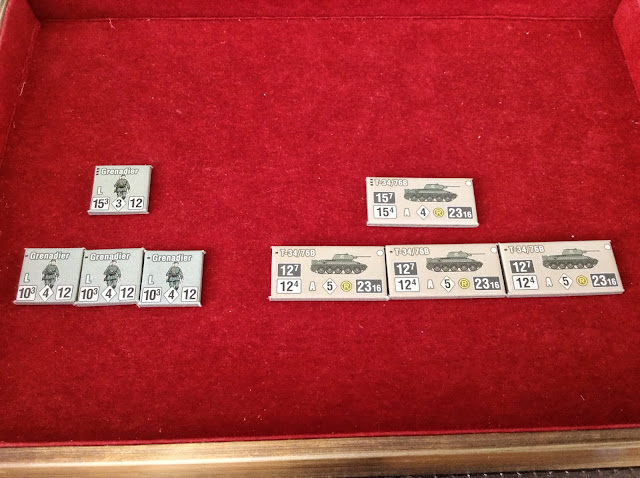
Here was the situation on the
battlefield for the first scenario.... The Soviets quickly take several
objectives as they advance from the south, up through the small town
where they encounter the Germans...
The Germans conduct an artillery barrage with their medium battery. The Soviets take some hits but hold their position!
The Soviets throw it right back at the Germans issuing a strafing run with a fighter bomber!
After several rounds, the Axis tanks finally push through and make their way into the town...
The Soviets are getting overrun by German Stugs but manage to hold onto the choke point.
... It doesn't look good for this Russian T-34 on the east side of the map either...
The end of the game saw the Soviet forces suffering heavy casualties but they managed to hold onto their victory objectives for the win!
So far, I've really enjoyed playing Fighting Formations. The order matrix, combined with the command tokens, work hand in hand in making you feel the satisfaction (and frustration!!) of getting orders to your troops.
I also really love the use of the cards in the game, which gives the
players the ability to do artillery bombardments, aircraft attacks and
smoke grenades, to name a few. While, Fighting Formations is not a card driven game, the cards provide yet ANOTHER way to help swing the tides of battle and really adds a cinematic quality to
each game.
As far as components go, the game's production value is top notch, as can be expected from GMT games. Chits and counters are printed clearly with no visible misalignments and the maps are on heavier, semi-glossy paper. I'm a bit puzzled that the box wasn't a bit bigger, though. There are tons of counters in the game and once you put them in counter trays, with the stack of maps, cards, and player aids, you quickly run out of room. I was really hoping for a 3 inch tall box that Combat Commander came with, but oh well.
I also wish the hexes on the map were a bit larger. You'll be flipping lots of counters during the game and between multiple squads of infantry, tanks, markers and Command Tokens, hexes can quickly fill up and easily get knocked about.
The other nitpick would be the orientation of the tanks and guns on their respective counters. It's already been the topic of much discussion but I do agree that a top down (or 3/4) view of the guns and tanks would have served the game better. It does get a bit wonky when the counters get flipped for activation and you have to crane your neck to read stats because a tank has to be situated just so due to its facing on a hex. Conflict of Heroes solved this quite nicely by using 1 inch square counters with the stats on the bottom half and I think that worked quite well.
These are all minor quibbles on an amazing game, though. 'Fighting Formations' is a winner, through and through. I've been looking for a meatier war game experience since I started with Conflict of Heroes several years ago and followed that up with Combat Commander.
Fighting Formations seems to take the best of both these systems and manages to cram in even MORE gameplay. The rulebooks are a delight to read and raise the bar for clarity and functionality. Once you play a few rounds, all the game mechanics seem to click in a lovely, intuitive fashion and when you're finished, you'll continue to analyze what happened and look forward to playing again!
9/10
For more information on 'Fighting Formations', visit these links on boardgamegeek and GMT games.
Wednesday, August 28, 2013
Sunday, August 18, 2013
What I've been playing lately..... Aug 18 2013
Hayashi's 'Trains'
'Combat Commander' from GMT Games
'Android: Netrunner'
'Robinson Crusoe: Adventure On The Cursed Island'
Sunday, June 2, 2013
Saturday, March 2, 2013
Saturday, June 16, 2012
Le Havre
 |
| 'Le Havre at it! |
Hey Geekshelfers, settle down and let me tell you about a boardgame i've played recently.
It's called Le Havre and it's a worker placement game where you collect goods, buy buildings, build ships and essentially try to earn more money at the end of the game than your opponents!
| to Havre or Havre not! |
A game turn is actually very simple. Goods arrive on the offer spaces each turn and you can either swipe one type of good (fish, wood, clay, iron, etc.)....
| Starting setup for the short, two player game |
....Or you can place your pawn on a building and take its action. There are many different buildings that you can buy (using cash) or build (using the goods resources such as wood or steel).
Using a building lets you upgrade your goods. In the example below, I used the Abattoir to convert some cattle into meat which allows me to feed 3 workers and also get hide. Food is VERY important in this game because you have come up with increasing amounts of it to feed your workforce as the game goes on.
Coming up short on food means you need to spend money or take out a loan from the bank. BIG NO NO!
| Using the Abattoir to convert Cattle to meat. YUM! |
Here are my buildings during mid game:
| All my buildings, yo. |
You can specialize in certain goods but it's generally a good idea to be a bit flexible and get several types so you don't get screwed in the long run.
| A variety of goods. Yeah, you'll be needing these. |
As the game progresses, it's also worth noting that ships are VERY important. Not only do they reduce the amount of food you need to feed your workers, they also allow you to ship your goods for extra cash (victory points)!
| Joy builds a luxury liner. |
| I become a steel ship baron! |
It's also a little less punishing to the player if they're unable to feed workers. In short, it's not very hard to recover from a few starving workers if you take out a loan from the bank or sell off a marginally useless building.
The only downsides to the game are the slight fiddliness of the goods tiles (which you can avoid by using small containers-see first picture) and the possible length and brain burn due to players with analysis paralysis.
All in all, I highly recommend Le Havre. The new reprint is also great because it includes the Grand Hameau expansion. Check it out if you get the chance!
Le Havre on BoardgameGeek
Monday, January 16, 2012
Power Grid
Hey Geekshelfers! Recently, Joy took a bad fall while bouldering and sprained both her ankles. She's doing fine but she can't walk around and needs to stay off her feet for awhile. She was feeling a bit low but luckily, we had a few friends come over and play a board game to lift her spirits. The game was Power Grid!
In the game, players build power stations that supply electricity to houses on a map (we played the Germany map in the pic below).
Power plants are constantly auctioned off to the highest bidder and resources are purchased at market value. This power plant, for example, can supply power to 1 house using 2 oil.
Here's a close-up of the resource market. Coal is brown, oil is black, garbage is yellow and uranium is red. The more players buy a certain resource, the less of it there is and the more expensive it gets.
| resources become quite expensive! |
| You can build houses but can you provide enough power for them all? |
Here's a picture of the map late in the game.
| Powering houses across Germany! |
| supplying power to 10 houses! |
For more information on Power Grid, visit www.boardgamegeek.com
Happy Gaming!
Subscribe to:
Posts (Atom)





